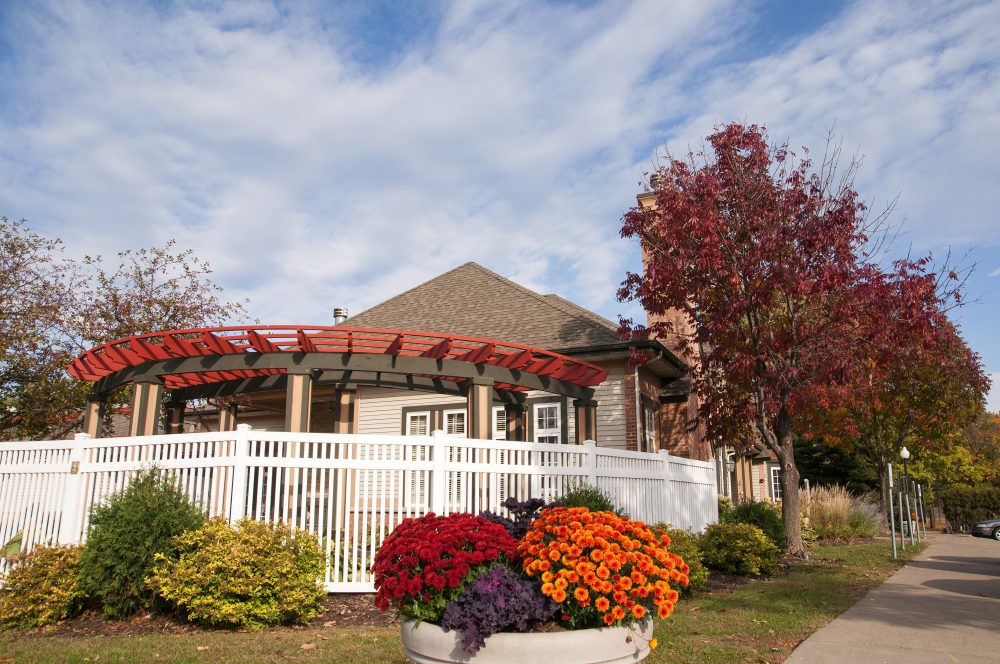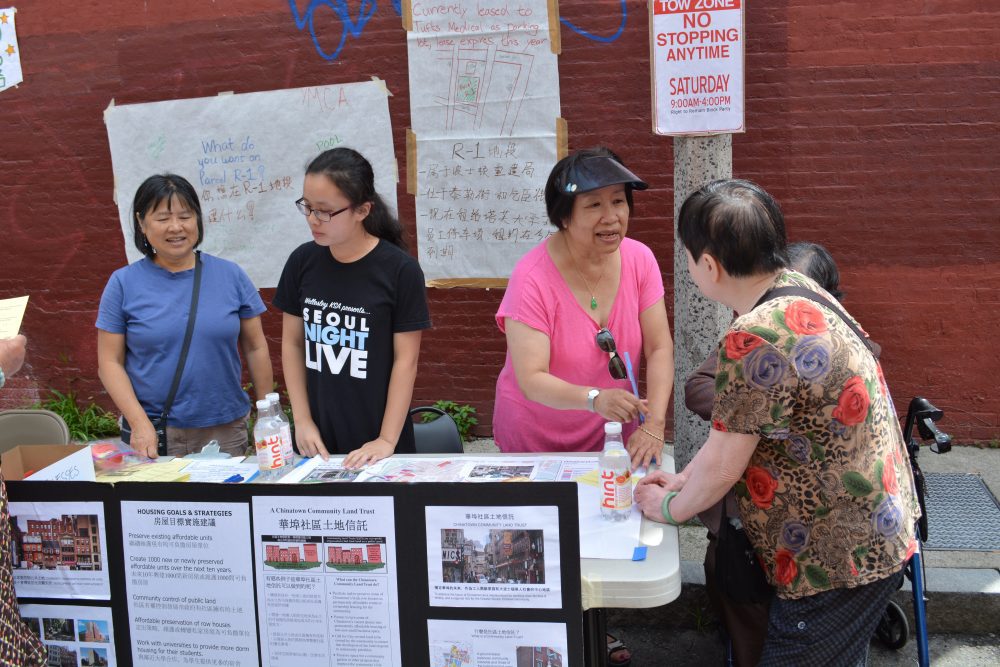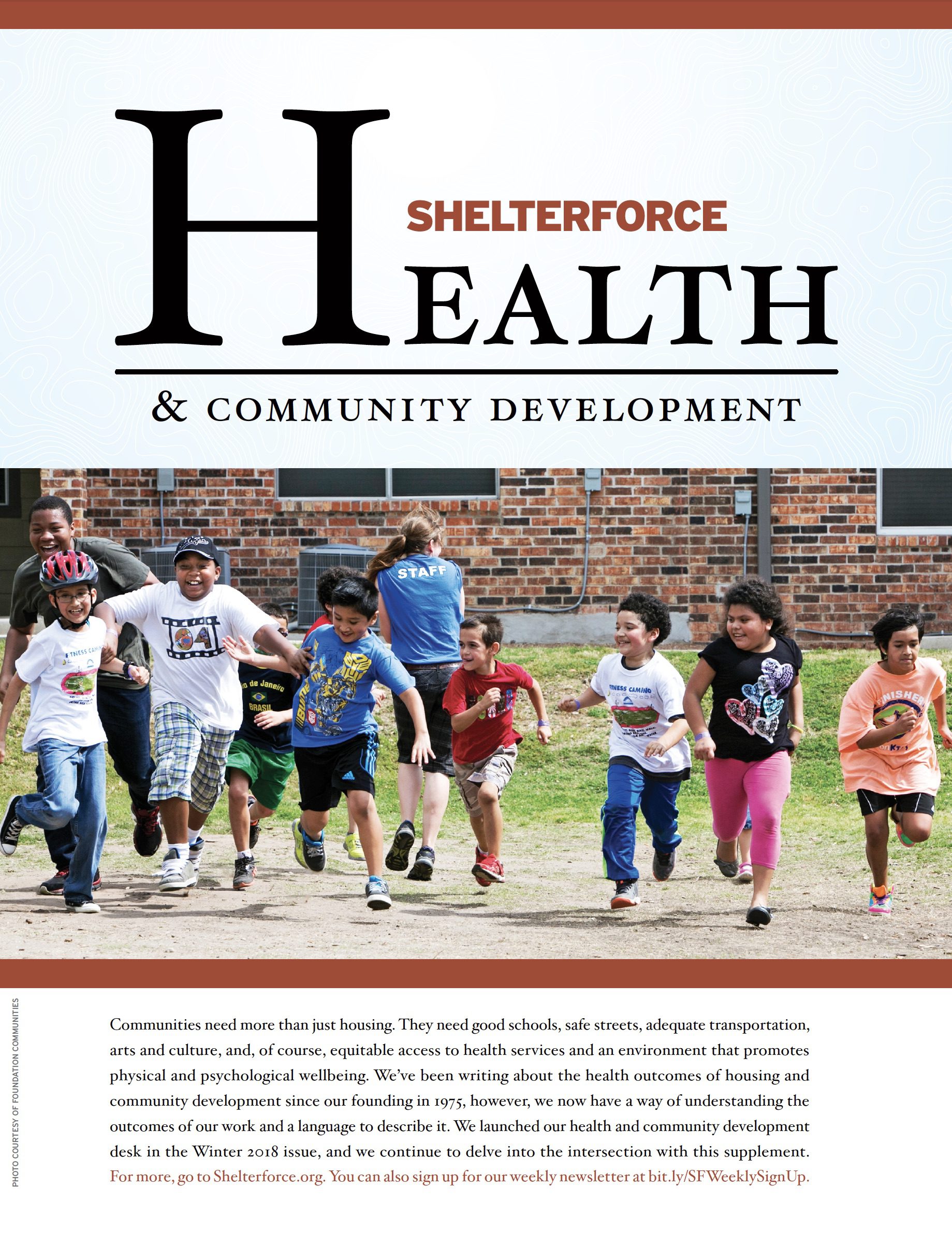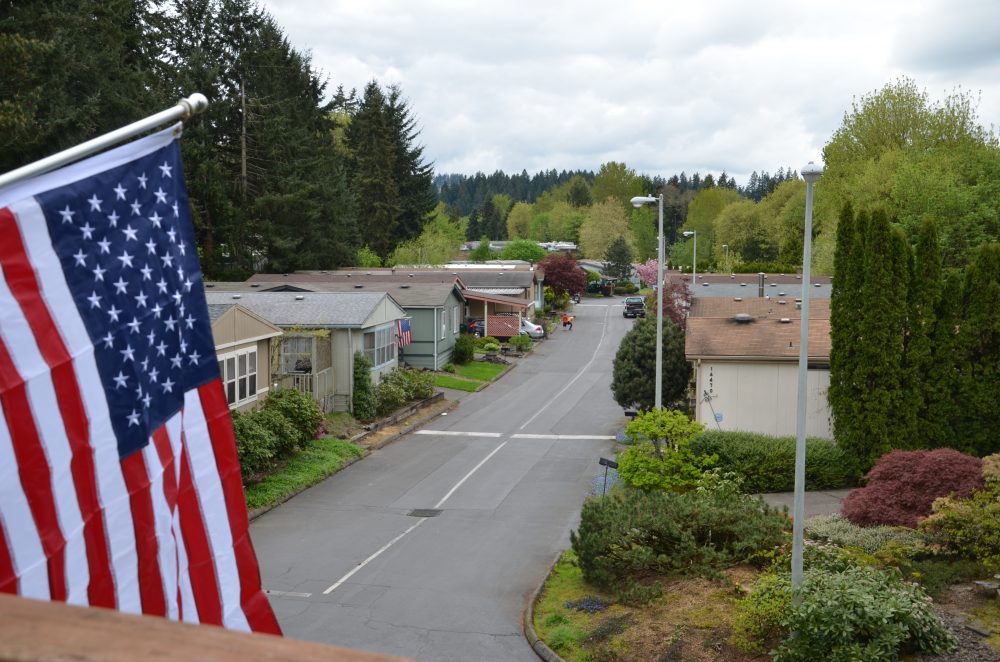
Aeon recently purchased Seasons Park, a 422-unit apartment complex in Richfield, Minnesota. The complex was under threat of being sold to a luxury developer. Photo courtesy of Aeon
It was late spring 2017 when Aeon president Alan Arthur got the call from Richfield City Council Member Maria Regan Gonzalez. A tenant had contacted her because he was worried that his apartment complex would soon be sold to a luxury developer, forcing out 400 working-class families and 250 school-age children who could not afford luxury-level rents. Not too long ago, the same scenario had occurred at a 700-unit apartment complex in Richfield, an inner-ring suburb of Minneapolis.
Aeon, a nonprofit founded in 1986, had developed around 2,800 units of affordable housing at that point, some of it new construction, some rehabbed from older stock. Like thousands of nonprofit affordable housing developers across the United States, Aeon had come to rely on low-income housing tax credits (LIHTC) to finance its work. Using these credits, nonprofits like Aeon have developed more than 372,000 units of affordable housing since the tax credit’s inception in 1987, according to data from the U.S. Department of Housing and Urban Development (HUD).
However, things have changed dramatically since 1987. Aeon and other nonprofits like it around the country are no longer working only in neglected corners of the real estate market that have been left behind by redlining or deindustrialization. As researchers like New York University sociologist Patrick Sharkey have brought to light, community organizing, community policing, changes in consumer taste wrought by popular culture, and other factors have combined to create a new real estate market in which the haves desire to live in many of the same neighborhoods they once left behind to the have-nots. But the haves move quickly, and so do the developers who seek to profit from them.
“We’re seeing investors and market-rate developers buying up class B & C properties, 1960s vintage, putting in some cosmetic upgrades and increasing the rents dramatically,” says Blake Hopkins, vice president for housing development at Aeon. “In the process, they’re displacing all the households that are there, moving folks out of the school districts they’re in, pushing them out into a challenging market where they can’t find apartments they can afford.”
While the terminology and the concept may be problematic, these housing units that are suddenly in investors’ crosshairs have come to be known as “naturally occurring affordable housing.” It’s housing stock that, when built years ago, no one ever thought luxury-unit seekers would want. There might be some Section 8 voucher holders in these units, but for the most part these homes were built without public subsidy and they’ve been operated without large-scale public subsidy or affordability restrictions on rents for years, maybe decades. Now they’re ripe for the picking by luxury developers, who often come in offering all-cash deals, closing much faster and with far less paperwork than the traditional tax-credit-fueled affordable housing transaction.
The established nonprofit affordable housing development system, based on a tax-credit allocation process built for a different era, is starting to adjust.
“Our goal is to go in and compete for these properties, and we still have to pay market value for them. We put in some improvements, but we try to keep those rents as stable as possible,” Hopkins says.
Within a week of that first phone call from Councilmember Regan Gonzalez, Hopkins says, a purchase agreement was in place. For $36 million plus $4 million in renovations and other “soft” costs, Aeon acquired all 422 units at the Seasons Park complex, which was under threat of being sold to a luxury developer. Everyone who wanted to stay at the complex could stay. “Our prayers were answered,” said one tenant.
It was Aeon’s largest single acquisition yet. A month later, the nonprofit would top that, with a 768-unit, $81 million acquisition of naturally occurring affordable housing in the Twin Cities metro area.
It was an exceptional year, probably not to be repeated in scale, but definitely a sign of things to come for Aeon and other nonprofit affordable housing developers like it across the country.
“We’re looking to add about 300 units of [naturally occurring affordable housing] per year, but it’s tough to say if they’ll come in one large transaction or a bunch of smaller transactions,” Hopkins says. “For every one deal we’ve made, probably 20 have come across our desk, though we haven’t bid on all of them.”
The New Capital Stack
The established model of tax-credit equity plus a permanent mortgage via bond financing, Freddie Mac or Fannie Mae, maybe with a pre-development, acquisition, or bridge loan in the mix, is too slow and too limited to compete for naturally occurring affordable housing. It can take anywhere from a few months to a year, sometimes multiple years, before winning an allocation of low-income housing tax credits, which, while federal, are administered at the state level. Only a limited amount of low-income housing tax credits are available every year. Many viable projects get left on the table, and may or may not survive to try again the following year, or the year after that.
The number of naturally occurring affordable housing units is larger than all 2.1 million remaining tax-credit subsidized housing units combined. Even though there isn’t a clear fix on exactly how many units of naturally occurring affordable housing there are, by combining census bureau and CoStar data, the Urban Land Institute estimated 5.5 million units. Fannie Mae estimated 8.5 million such units in its proposed Duty-to-Serve plan last year.
On a more limited, but more urgent basis, the Urban Institute mapped units rented by extremely low-income households (those earning at or below 30 percent of the area median income) across the country, finding 2.5 million households living in units affordable to them without any rental assistance. These are units that could be most easily picked off by a speculative luxury developer, following the rule of buy low, sell high.
What is clear is that the nation’s rental stock is moving up-market. Nationally, Harvard’s Joint Center for Housing Studies’ annual rental housing report shows, additions to the rental housing stock have shifted dramatically toward higher-end apartments.
In Minnesota, the Sold Out report from the Minnesota Housing Partnership revealed that sales of existing apartments have accelerated since 2009, with sales prices increasing dramatically and growth in renter populations heavily tilted toward higher-end renters. In a sign that high-end renters are really returning to areas that such populations once left behind due to redlining, the report found that a disproportionate number of rental units were being sold in moderate-income neighborhoods with a high percentage of people of color.
For Aeon and other nonprofit developers, going beyond their tax-credit-fueled comfort zone requires a new combination of sources of capital. Instead of selling tax credits, a nonprofit’s next option is to sell part-ownership in their properties to equity partners, giving up some of the rental income, often the lion’s share, from their properties. In a typical example, the equity partner supplies 90 percent of the equity needed for a deal (18 to 27 percent of the total deal), with the nonprofit ponying up the rest of the equity needed, and the remaining 70 to 80 percent of the overall acquisition and renovation cost coming from a housing finance agency, or Freddie Mac or Fannie Mae.
A range of organizations has emerged to step into the equity partner role to work with nonprofits on naturally occurring affordable housing deals. Aeon has already had the chance to work with multiple such partners.
On its first naturally occurring affordable housing acquisition in 2016, which consisted of 130 units, Aeon worked with the Housing Partnership Equity Trust, a real estate investment trust (REIT) jointly created in 2013 by the national Housing Partnership Network of nonprofit affordable housing developers across the United States. For the 422-unit Richfield transaction, Aeon worked with Community Development Trust, launched in 1999 as the nation’s first community development REIT.
REITs have an interesting history in the United States. Congress created REITs in 1960, ostensibly to allow a wider swath of people access to the benefits of real estate investment, including income from tenant rents. The idea was to create a vehicle in which people could pool their money, and that vehicle could finance the acquisition and development of multiple properties spread out all over the map—reducing risk by keeping a diverse geographic portfolio. There are more than 200 REITs listed on stock markets today, accounting for some $960 billion in investor dollars deployed around the country. If you’ve got a 401(k) or other savings invested in a mutual fund, it’s likely some of your money is invested in one or more REITs.
Under the conventional publicly traded model, REITs are purely profit-maximizing creatures, built to maximize returns for shareholders and liable if they don’t. Both Housing Partnership Equity Trust and Community Development Trust are privately owned and privately traded REITs—you can’t buy shares of them on the stock markets. While they are tax-paying, for-profit entities, being privately owned means they can be more strategic, acquiring ownership stakes to preserve or expand affordable housing portfolios instead of flipping them to market rate, and yet as REITs they both also benefit from large investors’ familiarity with the structure.
Community Development Trust raised $31.75 million in its first private sale of shares to investors in 1999. It recently closed its fifth private sale, selling another $33 million in shares to investors, bringing its total shares sold to $220 million (it has also received capital from other sources, like the U.S. Treasury’s CDFI Fund). The trust’s investors include large banks, which get credit for those investments under the Community Reinvestment Act, as well as large insurance companies that don’t need or get any such credit. There aren’t any tax credits for investing in a REIT, even one like Community Development Trust. Like most other REITs, the trust pays investors a share of rental income every quarter based on how much each has invested.
The REIT structure makes for an ideal long-term ownership partner for nonprofit affordable housing developers like Aeon. By selling shares instead of borrowing from investors, a REIT generally doesn’t have to repay investor capital within a set time frame, so it doesn’t need to cash out of properties to repay its investors. Community Development Trust still owns a stake in the first property in which it invested, Summerfield Townhouses in East Hartford, Connecticut.
REITs like Community Development Trust and Housing Partnership Equity Trust are also rooted in the world of mission-driven affordable housing developers. Housing Partnership Equity Trust is directly controlled by a national network of nonprofit affordable housing developers, while Community Development Trust started out as a spin-off from the Local Initiatives Support Corporation, which has financed 365,922 affordable homes and apartments since 1980, much of it built by local nonprofit developers.
While not a REIT, Enterprise Community Partners is also active in the equity partners game and joined Aeon as equity partner on six of the ten properties making up last year’s 768-unit acquisition.
For the other four properties in the 768-unit acquisition, Aeon worked with a new entrant into the equity partner game, a local entrant—the Greater Minnesota Housing Fund’s Naturally Occurring Affordable Housing Impact Fund.
Rallying New Local Investor Dollars
Looking at the changing Twin Cities rental market, Rachel Robinson of the Greater Minnesota Housing Fund couldn’t help but feel like she and her colleagues in affordable housing were fighting the mythical Hydra, with two heads sprouting for every one they cut off. The metaphor fits like a hat: for every new unit of affordable housing created per year across the country, two are lost due to deterioration, abandonment, or conversion to more expensive housing, according to the National Housing Trust.
“All of a sudden we were seeing all those pressures push on the rental market here,” Robinson says. “We are losing [naturally occurring affordable housing] faster than we can create new affordable rental housing.”
The Greater Minnesota Housing Fund, a nonprofit founded in 1996, is a federally certified community development financial institution (CDFI) that has been part of the conventional affordable housing capital stack, providing loans for pre-development, acquisition, and construction; bridge loans; and even some long-term financing for 14,100 affordable homes and counting across Minnesota. But it too was feeling the equity crunch—the limits on production and preservation potential from relying on low-income housing tax credits.
Going beyond its tax-credit comfort zone, the nonprofit rallied a range of investors to form the NOAH Impact Fund, which has a goal of raising $50 million over two years to preserve 1,000 units of naturally occurring affordable housing at risk of converting to higher-end development in the Twin Cities metro area. Like a conventional “structured equity” fund, which a venture capital or private equity firm might form, the nonprofit pooled capital from a variety of investors who aren’t necessarily seeking the same deal.
“The idea was to deepen impact, bring new players to the table, and create a local fund that could enhance the number of units of naturally occurring affordable housing preservation that could be done in any given year,” Robinson says.
Three local banks so far have provided the majority of NOAH Impact Fund’s capital, including Sunrise Banks, which is also a federally certified CDFI. The banks made 10-year loans into the fund, earning a competitive rate of return with zero tax credits involved, but also potentially getting some credit for the investments under the Community Reinvestment Act. It is a departure from a bank’s typical role as a mortgage financier.
“These banks have not been directly financing affordable housing at [the equity] level,” Robinson says.
The McKnight Foundation, based in Minneapolis, came in with a $5 million loan to the NOAH Impact Fund at 2 percent interest, which qualifies as a program-related investment due to the below-market rate of interest combined with mission-aligned goals. Growing numbers of smaller and local foundations are making use of program-related investments, pioneered by the Ford Foundation in the 1980s, as an alternative to grants in cases where a low-interest loan makes more sense. The Otto Bremer Trust, another local foundation, also made a $1 million program-related investment into the fund (Otto Bremer Trust also owns Bremer Bank, which was one of the banks that made a market-rate loan to the fund).
By combining the market-rate capital from banks with below-market rate capital from foundations and the county, the $25 million NOAH Impact Fund can turn around and provide capital to developers on terms that make it possible to keep rents affordable for the target range of households—those earning up to 60 percent of the area median income for the Twin Cities metro, or between $550 and $1,200 a month, depending on the size and age of the unit.
The fund is built to help developers compete, expecting them to acquire properties at market prices. “We rely on buyers to bring us deals,” says Robinson.
For the 768-unit acquisition by Aeon, involving the NOAH Impact Fund and Enterprise as equity partners, the purchase was made on the open market with major national brokerage firm CBRE serving as the broker. “They do a lot of the work here in terms of NOAH,” Hopkins says of CBRE.
The key to competing is being able to promise speed and reliability that the permanent financing, from a Freddie Mac, Fannie Mae, or some other place, is going to be at the end of the rainbow for the seller. Developers can’t rely on friendly sellers willing to wait or offer a lower price just because a buyer happens to promise not to displace anyone from the property.
“We’ve pushed to be nimble, quick-strike capital,” Robinson says. “It’s still a myth I have to unwind that just because we want to maintain affordability we’ll take longer than another buyer. This is a new dawn, a new era for affordable housing nonprofits. We’ve all worked hard to build aggressive buying teams so that we can play ball in this field with the rest of the private market. A lot of the staff doing preservation at affordable housing nonprofits has come from the private sector.”
When approaching potential sellers, developers working with the NOAH Impact Fund can count on at least two letters to help back them up—one from the fund promising to step in as an equity partner, and another from Freddie Mac, which has made an advance commitment of $100 million in mortgage financing for NOAH Impact Fund transactions.
That said, there is still an “upper limit” to the speed the NOAH Impact Fund can offer. Even with Freddie Mac standing behind the fund, the standard Freddie Mac mortgage underwriting process takes about 30 days to close. Robinson is confident that if the mortgage underwriting process can be that fast, the Greater Minnesota Housing Fund can be that fast. “Structurally at some point we just can’t move any faster than the world around us,” she says.
When the transaction is done, one more crucial public sector piece comes into play that makes it possible to keep the rents affordable—Minnesota has a state program that limits the property tax assessments below market value for every unit on a property that is rented out at rates affordable for households at or below 60 percent area median income. That means that affordable housing developers can pay market rate to acquire units without having to pay the full property tax based on the market value per unit.
“It’s not complete abatement, but you pay maybe 60 percent of what you would pay if it was a market-rate building,” Hopkins says.
Technically, the tax abatement means the units are no longer “naturally” affordable, but the point is to be able to acquire existing affordable units and preserve them as affordable instead of leaving them vulnerable to higher-end conversion.
As a local nonprofit equity partner, the NOAH Impact Fund can just as easily work with for-profit affordable housing developers to preserve the affordability of naturally occurring affordable housing units. They’ll typically come in as a 90 percent joint-owner of a property, giving them the ability to enforce affordability restrictions.
“There’s a lot of terms and conditions that go along with our investments,” Robinson says. “There’s probably less of a difference [between nonprofits and for-profit developers] than most would presume, because they all need to have good business practices and treat tenants well.”
Robinson admits that all the naturally occurring affordable housing out there isn’t necessarily up to par with today’s standards, but contends that it doesn’t mean those are units that should be turned over to luxury developers without a fight. The fund expects to build in about $10,000 worth of improvements per unit it preserves, much of which Robinson says will likely go to resolving roof issues or drainage issues, or energy and water efficiency improvements.
“Brown was the color of the ‘80s,” she says. “It’s not always camera-ready housing, but it’s still providing a really important affordable housing resource.”




Comments